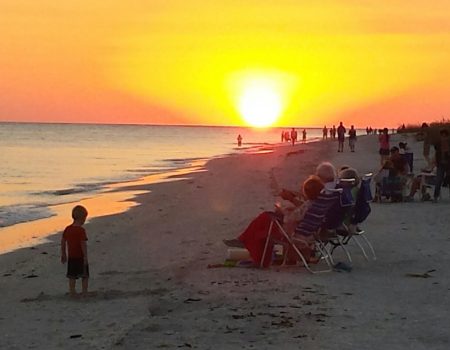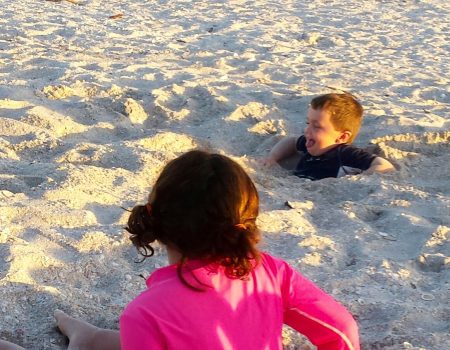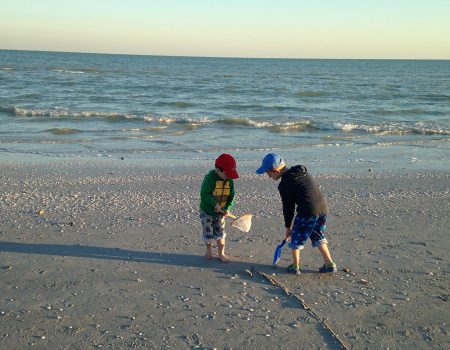Hi, my name is Dave Herrick. My wife Sandy and I live north of Boston and we have owned this unit since 2004. We have been coming to Sanibel for over 30 years. We owned a condo in the 80s which we unfortunately sold in 1992. Ever since then, we have been hoping to be able to someday re-establish an ownership position on the Island. Our desire is to establish a high quality, well maintained unit to which our guests will want to return to, year after year.
During the 80s we made Sanibel our annual vacation, usually over the Holidays to coincide with school vacations for our three boys. Sometimes we had Christmas trees and boats in tow. Sometimes it was grandparents joining us to escape the Boston cold. On every occasion, it was a trip we all looked forward to with excitement and anticipation. My kids learned to swim on Sanibel. This is where they saw their first alligator in the wild. We took daily bike rides on the miles of bike paths and explored the wildlife at the numerous sanctuaries. Sometimes we just walked the beach at low tide and talked about whatever interesting shells or other sealife we found. Overall, Sanibel became a very special place in our lives. It became a place we all enjoyed together; a difficult concept to achieve in a diverse and growing family. During the nineties, we missed our southern sojourns, but with the kids involved in school activities and moving on to college, it became increasingly difficult to schedule family trips. Interestingly, with the kids now through school and with kids of their own, they have rekindled their own memories and attraction to the Island.
We have enjoyed this new phase in our lives and look forward to continuing to share our Sanibel home with our family and with other new and returning visitors.
Dave and Sandy Herrick
THE HISTORY OF SANIBEL ISLAND
Sanibel and its sister island Captiva are part of a chain of barrier islands skirting the southwest coast of Florida. Most of these islands are parallel to the shore line. Sanibel, however, is crescent-shaped and extends further into the Gulf, creating a haven for fish and wildlife sheltered in the bays behind our island. With more than 12 miles of Gulf of Mexico beaches and about three miles across at its widest point, Sanibel’s history is rich with native peoples, Spanish explorers, brave pioneers, settlers and now, residents and vacationers from all over the world.
Sanibel and Captiva are believed to have been formed as one island about six thousand years ago. Sediment from the Caloosahatchee River was carried into the Gulf of Mexico and shaped over the years by hurricanes and tropical storms. It is believed that people have lived on Sanibel since the beginning.
The first known residents of Sanibel Island were the native Calusa Indians. A warlike people driven from the shore by the 1700s, their settlements were discovered due to the mounds of shells they left behind. The whelks, conchs, clams and oysters were used for food, their shells for tools, and large numbers of the empty shells were discarded in great heaps likely used for ceremonial purposes.
In 1513, Juan Ponce de Leon made landfall nearby, and is credited with discovering Sanibel and Captiva along with La Florida. Some historians believe Amerigo Vespucci may have explored the area thirteen years earlier, with his findings documented in a map from 1502.
There are many stories about how Sanibel and Captiva islands were named. Ask around and you’ll most likely hear that Captiva Island was named by pirate Jose Gaspar, who used the island to hide kidnapped women until their ransoms were paid, hence “Captiva”. While it’s thought Ponce De Leon named Sanibel after Queen Isabella, the names can also be traced to the earliest known maps of Florida as “S. Nivel” and “San Ybel”.
A Spanish map and navigation guide dated 1527 mentions areas traveled and named by Ponce de Leon. The name “Costa de Carocoles” – the coast of seashells – was given to the stretch of barrier islands that include Cayo Costa, Gasparilla, Captiva and Sanibel. The navigation guide describes a crescent-shaped island with a shallow inlet, probably referring to Sanibel’s Tarpon Bay.
Ambitious Spanish explorers found no treasure, and a hostile Calusa population. A Calusa arrow killed Ponce de Leon when he returned to the area in 1523. As with many native tribes, war and disease took their toll, and the Calusa were forced inland by European settlers. The Spanish were unsuccessful in establishing any kind of permanent settlement. For about two centuries the islands only receive brief mention in history as hideouts for pirates raiding Spain’s shipments of treasure from Central and South America and later the cargo ships destined for the port of New Orleans.
By 1774, Bernard Romans, commissioned to map the area for the British, referred to the island on his maps as alternately “Sanybel” and “San Ybell.” One year later the island appeared as “Sanibel” on a Spanish map and that is how it has remained.
For most of the 1800s, in fact until the end of the US Civil War Sanibel Island was still a rugged outpost. Indian raids during Florida’s Seminole Wars kept settlers and fishermen on their toes through the 1850s.
Cuban fishing camps were common in the bays behind Captiva and Sanibel, shipping salted dried fish to Key West and Havana. Sanibel settlers grew citrus and vegetables to supplement their diets of fresh local seafood. Wild turkey, hogs, deer and sea turtles rounded out the early settlers’ menus.
Florida became a US Territory in 1821 when Spain sold La Florida to the United States for $5 million. The Sanibel region was called “The Buccaneer Coast” and barrier islands were havens for pirates and plunderers. The US Navy worked to rid the coast of pirates, and once the threat was gone Sanibel Island was the site of a small colony started by the Florida Peninsular Land Company, a group of New York investors, in 1832.
On March 3, 1845 Florida was admitted into the Union as the 27th state. Only during and after America’s Civil War would increased military activity around Fort Myers and San Carlos Bay make the area once again safe for settlers.
By the late 1870s, Punta Rassa had become a busy port for shipping cattle to Cuba. In 1869 William Allen, one of Sanibel Island’s first homesteaders built a castor bean plantation near the only fresh water well on the island.
Congress debated construction of the lighthouse and acquiring land on Sanibel in the late 1870s. Construction began in 1884, and the foundation of the light was completed in three months. The schooner carrying the disassembled iron tower from Jersey City sank about two miles from the lighthouse site. Hard hat divers salvaged two pieces of the tower. First lit with a kerosene lantern on August 20, 1884, the iron skeleton tower has a central spiral staircase beginning about 10 feet above the ground and 127 steps lead to the light.
By May of 1889, there were twenty-one houses and forty families living on Sanibel with a population of one hundred. In 1892, with a permanent population nearing 100, Sanibel built its first schoolhouse. By the twentieth century, both Sanibel and Captiva supported farm communities. Crops of avocado, melons, citrus, peppers, tomatoes and eggplant were sent to the mainland aboard steamships.
The area of Sanibel near the lighthouse is considered “Old Town Sanibel”, the area of the island that was once the center of activity. Most of Sanibel’s early pioneers passed through this point in the late 19th and early 20th centuries. The lighthouse is Sanibel’s oldest standing structure.
Sanibel’s farmers were thriving when the first of two major hurricanes struck the island in 1921. The second, in 1926, had tides exceeding 14 feet, completely covering all low-lying areas of both Sanibel and Captiva. Island agriculture never recovered, but a new source of revenue had begun: hospitality.
Word of Sanibel’s natural beauty, unmatched shelling, and fantastic fishing started to spread, and with ferry Service beginning in 1925, the island’s visitor population continued to grow. World War II only slowed growth a little. The lighthouse went dark, and a lookout tower was built just to the south. It was the end of World War II before Sanibel began to welcome visitors eager to escape the hard times behind them. Cottages, Inns and Fishing Camps were built to accommodate the steady stream of visitors from the mainland, and Sanibel and Captiva hosted many notable celebrities, including the Lindberghs and members of the Roosevelt family.
Throughout the 1950s and 1960s Sanibel’s guest community grew rapidly. Island visitors were drawn by Sanibel’s famous beaches, shelling, fishing, and exotic wildlife such as shore birds, alligators, dolphins and manatees.
Many older island residents and visitors personally remember the half-hour ferry rides and stocking up for the week at Bailey’s General Store before the Sanibel Causeway was completed in 1963. It was apparent from the start that the Sanibel Causeway was going to change the face of the Island. Many were afraid Sanibel would be overrun by developers and lose its charm and natural heritage. It took only 11 years for Sanibel to form its own city government, allowing island leaders and citizens to control their own destiny in preserving the island.
A vacation on Sanibel is a visit to Natural Florida. Conservation and living in harmony with nature have always been a part of living on these beautiful islands. All of Sanibel and parts of Captiva were declared a national wildlife refuge in 1945, and land use restrictions enacted in 1974 still guide development and landscaping.
Six thousand acres of mangrove, bay and estuary are now the J.N. “Ding” Darling National Wildlife Refuge. More than 750,000 people now tour this wildlife refuge each year. Visitors can explore the 5-mile wildlife drive by car, bike, or on foot, and may see any of 200 species of birds, sometimes even at close range. Trails, an observatory tower, canoe or kayak rentals, whatever your choice, it’s an encounter with Natural Florida you won’t forget.
Sanibel beaches are still ranked third in the world and first in North America for the number of varieties of shell species. If shells are your fancy, be sure to visit the Bailey Matthews Shell Museum during your stay.
Residents of Sanibel and Captiva work hard to preserve the beauty and wildlife of our barrier islands. People choose to vacation here for our clean and non-commercial beaches and quiet, beautiful surroundings. There are few other places where you can experience the comforts of home, fine dining and night life, shopping and the arts – yet still see dolphins, manatees, ospreys and bald eagles, and seabirds skipping along the shore just out of reach.
Here on Sanibel we’re proud to host generation after generation of families who could travel anywhere, yet choose to come back to Sanibel again and again. Whether it’s your first visit or your twenty-first visit, we welcome you to our beautiful island and our ocean front home.




